Centauri Dreams
Imagining and Planning Interstellar Exploration
Lab Work on ‘Super-Earth’ Atmospheres
How we do laboratory work on exoplanet atmospheres is an interesting challenge. We’ve worked up models of the early Earth’s atmosphere and conducted well-known experiments on them. Still within our own system, we’ve looked at worlds like Mars and Titan and, with a good read on their atmospheric chemistry, can reproduce an atmosphere within the laboratory with a fair degree of accuracy.
In the realm of exoplanets, we’re in the early stages of atmosphere characterization. We’re getting good results from transmission spectroscopy, which analyzes the light from a star as it filters through a planetary atmosphere during a transit. But thus far, the method has mostly been applied to gas giants. Getting down to the realm of rocky worlds is the next step, one that will be aided by space-based assets like the James Webb Space Telescope. Can lab work also help?
Probing the Atmosphere of a ‘Super-Earth’
Worlds smaller than gas giants are plentiful. Indeed, ‘super-Earths’ are the most common planets we’ve found outside our own Solar System. Larger than the Earth but smaller than Neptune, they present us with a challenge because we have no nearby examples to help us project what we might find. That leaves us with computer modeling to simulate possible targets of observation and, in the lab, experimentation to see which mixture produces what result.
At Johns Hopkins University, Sarah Hörst has been conducting experimental work that varies possible exoplanet atmospheres, working with different levels of carbon dioxide, hydrogen and water vapor, along with helium, carbon monoxide, methane and nitrogen. Hörst and team adjust the percentages of these gases, which they mix in a chamber and heat. The gaseous mixture is passed through a plasma discharge that initiates chemical reactions within the chamber.
The research team used JHU’s Planetary Haze Research chamber (PHAZER) to conduct the experiments. A key issue is how to choose atmospheric compositions that would be likely to be found on super-Earths, as the paper on this work explains:
Atmospheres in chemical equilibrium under a variety of expected super-Earth and mini-Neptune conditions can contain abundant H2O, CO, CO2, N2, H2 and/or CH4, various combinations of which may have a distinct complement of photochemically produced hazes, such as ‘tholins’ and complex organics in the low-temperature, H2-rich cases, and sulphuric acid in the high-metallicity, CO2/H2O-rich cases. Warm atmospheres outgassed from a silicate composition can also be dominated by H2O and CO2. We therefore chose to focus on a representative sample of gas mixtures that are based on equilibrium compositions for 100×, 1,000× and 10,000× solar metallicity over a range of temperatures from 300–600?K at an atmospheric pressure of 1?mbar.

Image: This is Figure 2 in the paper. Caption: Due to the large variety of gases used for the experiments, this schematic provides a general idea of the setup. The details varied depending on the gases used, with attention paid to the solubility of gases in liquid water, condensation temperatures and gas purity. Credit: Sarah Hörst/JHU.
At issue is the question of haze, solid particles suspended in gas that can make it difficult to gauge the spectral fingerprints that identify individual gases. You might recall the clear upper atmosphere scientists found at the ‘hot Saturn’ WASP-39b (see Probing a ‘Hot Saturn’). Using transmission spectroscopy on this world, much larger than a super-Earth, Hannah Wakeford’s team at STscI found clear evidence of water vapor, and a surprising amount of it.
It was the fact that WASP-39b’s upper atmosphere is apparently free of clouds that allowed such detailed study of the atmospheric constituents. When we’re dealing with planets with haze, our ability to read these signs is more problematic. Learning more about the kinds of atmospheres likely to be hazy should help us refine our target list for future observatories.
Hörst’s laboratory work probes the production of haze, as the scientist explains:
“The energy breaks up the gas molecules that we start with. They react with each other and make new things and sometimes they’ll make a solid particle [creating haze] and sometimes they won’t,” Hörst said. “The fundamental question for this paper was: Which of these gas mixtures – which of these atmospheres – will we expect to be hazy?”
Two of the atmospheres in which water was dominant turned out to produce a large amount of haze, an indication that haze is not solely the result of interactions in methane chemistry. From the paper:
The two experiments with the highest production rates had the two highest CH4 concentrations, but the one with the third highest production rate (10,000× at 600?K) had no CH4 at all, demonstrating that there are multiple pathways for organic haze formation and that CH4 is not necessarily required. In the case of the experiment with no CH4, the gas mixture had CO, which provided a source of carbon in place of CH4. However, it is important to note that the production rates are not simply a function of carbon abundance, C/O, C/H or C/N ratios in the initial gas mixtures. This result also demonstrates the need for experimental investigations to develop a robust theory of haze formation in planetary atmospheres.
The researchers found a wide variation in particle color as a function of metallicity. The color of particles produced in the haze turns out to have an effect on the amount of heat it traps. Such findings may have implications for astrobiology, when we consider that primitive layers of haze could shield life in its early stages, preventing energetic photons from reaching the surface.
This work is in its early stages, as the paper makes clear:
Although models of atmospheric photochemistry and haze optical properties provide good first estimates, they are incomplete and biased due to the relatively small phase space spanned by the Solar System atmospheres on which they are based. Laboratory production of exoplanet hazes is a crucial next step in our ability to properly characterize these planetary atmospheres. These experimental simulations of atmospheric chemistry and haze formation relevant to super-Earth and mini-Neptune atmospheres show that atmospheric characterization efforts for cool (T?< ?800?K) super-Earth- and mini-Neptune-type exoplanets will encounter planets with a wide variety of haze production rates.
The paper also reminds us that hazes will have an effect on reflected light, which will have a bearing on future direct imaging of exoplanets. Lab work like this is part of building the toolsets we’ll need for probing rocky worlds around nearby stars in search of biosignatures. My assumption is that in the early going, we are going to see a lot of ambiguous results, with atmospheres with potential biosignatures being likewise capable of interpretation through abiotic means. Homing in on the most likely targets and understanding the chemistry at play will give us the best chance for success when looking at worlds so unlike any in our own system.
The paper is Hörst et al., “Haze production rates in super-Earth and mini-Neptune atmosphere experiments,” Nature Astronomy 5 March 2018 (abstract).

Juno’s View of Jupiter’s Turbulent Poles
The imagery we’re getting of Jupiter’s polar regions is extraordinary. Juno’s Jovian Infrared Auroral Mapper instrument (JIRAM) works at infrared wavelengths, showing us a vivid picture of a massive central cyclone at the north pole and eight additional cyclones around it. In the image below, we’re looking at colors representing radiant heat, with yellow being thinner clouds at about -13 degrees Celsius, and dark red representing the thickest clouds, at about -118 degrees Celsius. JIRAM can probe down to 70 kilometers below the cloud tops.
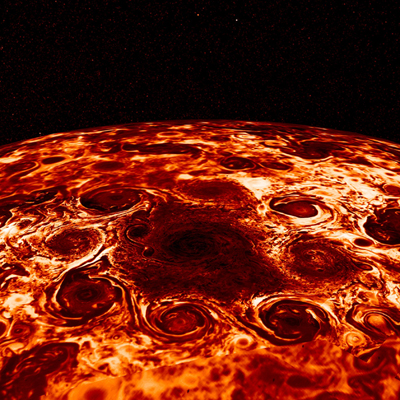
Image: This composite image, derived from data collected by the Jovian Infrared Auroral Mapper (JIRAM) instrument aboard NASA’s Juno mission to Jupiter, shows the central cyclone at the planet’s north pole and the eight cyclones that encircle it. Credit: NASA/JPL-Caltech/SwRI/ASI/INAF/JIRAM.
This is hardly the orange, white and saffron belted world we are familiar with from telescope views of the lower latitudes. The scale of these storms is, as you would expect with Jupiter, quite impressive. Alberto Adriani is a Juno co-investigator based at the Institute for Space Astrophysics and Planetology in Rome:
“Prior to Juno we did not know what the weather was like near Jupiter’s poles. Now, we have been able to observe the polar weather up-close every two months. Each one of the northern cyclones is almost as wide as the distance between Naples, Italy and New York City — and the southern ones are even larger than that. They have very violent winds, reaching, in some cases, speeds as great as 350 kph. Finally, and perhaps most remarkably, they are very close together and enduring. There is nothing else like it that we know of in the solar system.”
Adriani’s work on the Jovian polar regions is part of a four-paper set of Juno findings just published in Nature (citations below). We also learn that the planet’s south pole likewise contains a central cyclone, surrounded by five other cyclones with diameters ranging from 5,600 to 7,000 kilometers (the eight northern circumpolar cyclones have diameters between 4,000 and 4,600 kilometers). As Adriani tellingly asks, “…why do they not merge?”
Contrast this situation with Saturn, which houses a single cyclonic vortex at each pole, and it becomes clear that the differences between gas giants can be striking. We also see evidence at Jupiter that the winds dominating its zones and belts run deep, a phenomenon put on display by gravity measurements Juno has collected during its close flybys. “Juno’s measurement of Jupiter’s gravity field indicates a north-south asymmetry, similar to the asymmetry observed in its zones and belts,” said Luciano Iess, Juno co-investigator from Sapienza University of Rome, and lead author on a Nature paper on Jupiter’s gravity field.
That such asymmetries in gravitational measurements exist — and the visible eastward and westward jet streams are likewise shown to be asymmetric — tells us a great deal about how deep these powerful flows extend. This JPL news release explains that the deeper the jets flow, the more massive they are, creating a stronger signal in the gravity field. Juno’s gravity asymmetries thus become a marker for how far down these weather patterns extend.
The massive Jovian weather layer, east-west flows extending to a depth on the order of 3,000 kilometers, contains about one percent of the planet’s mass. Yohai Kaspi, lead author of another of the recent papers in Nature explaining the result, says that seeing the depth of these weather jets and their structure takes us from a two- to a three-dimensional view, adding: “The fact that Jupiter has such a massive region rotating in separate east-west bands is definitely a surprise.” We have much work ahead to determine what drives these jet streams; their gravity signature is entangled with that of Jupiter’s core.
On that score, the surprises seem likely to continue. For a final Juno result now being released suggests that the planet rotates below its massive weather layer as a rigid body.
“This is really an amazing result, and future measurements by Juno will help us understand how the transition works between the weather layer and the rigid body below,” said Tristan Guillot, a Juno co-investigator from the Université Côte d’Azur, Nice, France, and lead author of the paper on Jupiter’s deep interior. “Juno’s discovery has implications for other worlds in our solar system and beyond. Our results imply that the outer differentially-rotating region should be at least three times deeper in Saturn and shallower in massive giant planets and brown dwarf stars.”
Let’s close with a Juno image of Jupiter’s south pole as processed from JunoCam imager data by citizen scientist Gerald Eichstädt.
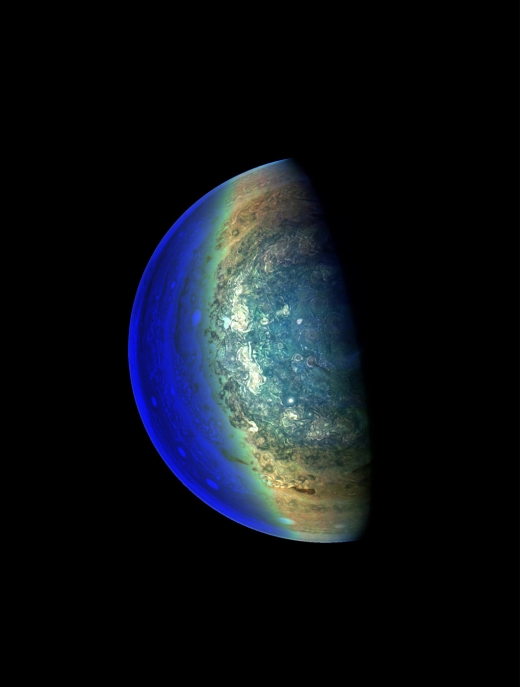
Image: This image captures the swirling cloud formations around the south pole of Jupiter, looking up toward the equatorial region. NASA’s Juno spacecraft took the color-enhanced image during its eleventh close flyby of the gas giant planet on Feb. 7 at 1011 EST (1411 UTC). At the time, the spacecraft was 120,533 kilometers from the tops of Jupiter’s clouds at 84.9 degrees south latitude. Credit: NASA/JPL-Caltech/SwRI/MSSS/Gerald Eichstadt.
All four papers are in Nature 555 (8 March 2018). They are: Adriani et al., “Clusters of cyclones encircling Jupiter’s poles,” 216-219 (abstract); Iess et al., “Measurement of Jupiter’s asymmetric gravity field,” 220-222 (abstract); Kaspi et al., “Jupiter’s atmospheric jet streams extend thousands of kilometres deep,” 223-226 (abstract); and Guillot et al., “A suppression of differential rotation in Jupiter’s deep interior,” 227-230 (abstract).

Extracting Exoplanet Topography from Transit Data
How do we go from seeing an exoplanet as a dip on a light curve or even a single pixel on an image to a richly textured world, with oceans, continents and, perhaps, life? We’ve got a long way to go in this effort, but we’re already having success at studying exoplanet atmospheres, with the real prospect of delving into planets as small as the Earth around nearby red dwarfs in the near future. Atmospheric detection and analysis can help us in the search for biosignatures.
But I was surprised when reading a recent paper to realize just how many proposals are out there to analyze planetary surfaces pending the development of next-generation technologies. Back in 2010, for example, I wrote about Tyler Robinson (University of Washington), who was working on how we might detect the glint of exo-oceans (see Light Off Distant Oceans for more on Robinson’s work). And Robinson’s ideas are joined by numerous other approaches. I won’t go into detail on any of these, but l do want to illustrate the range of possibilities here:
- Exomoon detection (see Sartoretti & Schneider, 1999, or the Hunt for Exomoons with Kepler and papers from David Kipping);
- Planetary oblateness — i.e., having an equatorial diameter greater than the distance between poles (Seager & Hui 2002; Carter & Winn 2010);
- Light from alien cities (Loeb & Turner 2012);
- Plant pigments (Berdyugina et al 2016);
- Industrial pollution (Lin, Gonzalez Abad, & Loeb 2014);
- Circumplanetary rings (Arnold & Schneider 2006).
I’ve pulled this list with references out of a paper suggesting yet another target, the surface topography of exoplanets. The work of graduate student Moiya McTier and David Kipping (Columbia University), the paper points out that while many of these effects are beyond the reach of current equipment, they are nonetheless valuable in pushing the limits of exoplanet characterization and helping us understand what technologies we will need going forward.
So is it really possible to detect surface features like mountains, trenches and craters on a distant exoplanet? McTier and Kipping make the case that we can draw conclusions about a planetary surface through what they call its ‘bumpiness,’ which should show up in a planetary transit as a scattering in the light curve produced as its silhouette gradually changes (assuming, of course, that we are dealing with a rotating planet in transit). We would obtain not the image of a specific mountain or other surface feature but a general analysis of overall topography.
The paper’s method is to model planetary transits for known bodies — the Earth, the Moon, Mars, Venus, Mercury — to see what it would take to tease out such a signature. We have ample elevation data for rocky planets in our Solar System. Using this information, we can model what would happen if one of them transited a nearby white dwarf. The researchers used thse values to find a general relationship between bumpiness and transit depth scatter.
In terms of bumpiness, the paper argues:
…the definition should encode the planet’s radius. An Everest-sized mountain on an otherwise featureless Mercury provides more contrast to the average planet radius than an Everest on an otherwise featureless Earth, and should result in a higher bumpiness value.
What we are after here is what the paper calls “an assessment of global average features,” one that incorporates the largest feature on a planet (an enormous mountain, for example) but also includes the contribution to the lightcurve scatter produced by all the planet’s features.
Mars, because of its small size and low surface gravity, turns out to be the bumpiest of these planets. A Mars-sized planet orbiting a white dwarf in its habitable zone proves to be an optimal situation for detecting bumpiness. Why white dwarfs? We learn that even huge ground-based telescopes planned for future decades such as the Extremely Large Telescope and Colossus would be unable to detect bumpiness on planets around stars like the Sun or M-dwarfs because of astrophysical noise and the limitations of the instruments. False positives through pulsations on the star’s surface, for example, can likewise appear as extra scatter in the light curve.
White dwarfs, on the other hand, appear unlikely to have convective star spots, but even if they do occur, McTier and Kipping argue that they can be detected and filtered out. Orbiting moons could similarly cause variations in the transit depth that could be mistaken for topography, but here the signature of the exomoons shows up just outside the ingress and egress points in the transit curve, unlike the topographical signature, which appears only in the in-transit data.
It turns out that the largest of our next generation of big telescopes would be able to work with a white dwarf planet, which the paper models as orbiting at 0.01 AU in the center of the star’s habitable zone. If we assume a mass typical of such stars (0.6 M☉), we get an orbital period of just over 11 hours. 20 hours of observing time covering some 400 transits with a telescope like the 74-meter combined aperture of Colossus should be able to detect topography.
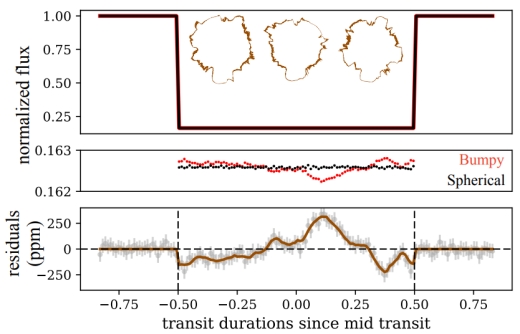
Image: This is Figure 8 from the paper, showing an oceanless Earth transiting a white dwarf. The caption: Top: Transits of a dry Earth with features (in red) and an idealized spherical Earth (in black) in front of a .01R☉ white dwarf with noise of 20 ppm added (20σ detection). The exaggerated silhouettes of Earth at different rotational phases are shown in brown. Middle: Zoomed-in frame of the bottom of the light curve in the top panel. Bottom: Residual plot showing the difference between the realistic and idealized transits. Grey shadows show the error bars on the residuals equal to 50 ppm. Dashed lines are to illustrate that residuals deviate from 0ppm only inside the transit. Credit: McTier & Kipping.
Surface features should tell us a good deal about a planet’s composition. From the paper:
…a detection of bumpiness could lead to constraints on a planet’s internal processes. Mountain ranges like the Himalayas on Earth form from the movement and collision of tectonic plates (Allen 2008). Large volcanoes like Olympic Mons on Mars form from the uninterrupted buildup of lava from internal heating sources. A high-bumpiness planet is likely to have such internal processes, with the highest bumpiness values resulting from a combination of low surface gravity, volcanism, and a lack of tectonic plate movement. Truly low-bumpiness planets are less likely to have these internal processes. On such planets, surface features are likely caused by external factors like asteroid bombardment.
I like the phrase the authors use in closing the paper, referring to their mission “of adding texture to worlds outside our own.” Texture indeed, for we are beginning to move into the realm of deeper planetary analysis, like a painter gradually applying detail to the roughest of sketches. Because of the magnitude of the challenge, we are coming at the question of exoplanet characterization from numerous different directions, as the list at the beginning of this post suggests. Synergies between their methods will be key to exoplanet surface discoveries.
The paper is McTier and Kipping, “Finding Mountains with Molehills: The Detectability of Exotopography,” accepted at Monthly Notices of the Royal Astronomical Society (preprint).

A New Theory of Lunar Formation
Simon Lock and Sarah Stewart are intent upon revising our views on how the Moon was formed. Lock is a Harvard graduate student who last year, in company with Stewart (UC-Davis) presented interesting work on what the duo are calling a ‘synestia,’ which is the kind of ‘structure’ resulting from the collision of huge objects. Current thinking about the Moon is that it formed following the collision of a Mars-sized object with the Earth, two huge objects indeed.
What Lock and Stewart asked is whether this formation scenario can produce the result we see today. What it calls for is the ejection of material that forms into a disk and, through processes of accretion, gradually becomes the Moon. The problem with it, says Lock, is that it’s a very hard trick to pull off:
“Getting enough mass into orbit in the canonical scenario is actually very difficult, and there’s a very narrow range of collisions that might be able to do it. There’s only a couple-of-degree window of impact angles and a very narrow range of sizes … and even then some impacts still don’t work.”
Perhaps we’ve misunderstood the original, massive collision. An adjusted formation scenario could explain why some volatile elements like potassium, sodium and copper are less abundant on the Moon than the Earth, and why isotope ratios for the Earth and the Moon are nearly identical. The ‘synestia’ hypothesis works like this: We still begin with an impact, but the assumed disk of raw materials never forms. Instead, the angular momentum of both colliding bodies is added together, creating a vast, indented disk much bigger than either object.
I’m going to drop back to an earlier Lock and Stewart paper for an illustration here.
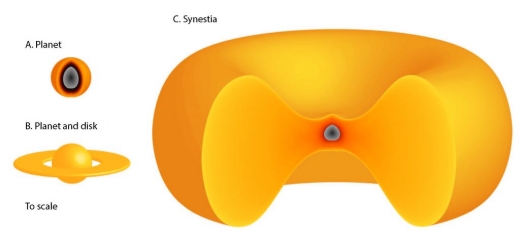
Image: The structure of a planet, a planet with a disk and a synestia, all of the same mass. Credit: Simon Lock and Sarah Stewart.
The 2018 paper describes a synestia as:
…an impact-generated structure with Earth-mass and composition that exceeds the corotation limit (CoRoL). Synestias are formed by a range of high-energy, high-AM [angular momentum] collisions during the giant impact stage of planet formation (Lock and Stewart, 2017, hereafter LS17). A synestia is a distinct dynamical structure compared to a planet with a condensate-dominated circumplanetary disk, and, as a result, different processes dominate the early evolution of a synestia.
So the synestia we get from major collisions — and these should be frequent in young planetary systems — is a rapidly rotating, partially vaporized object, molten or gaseous material expanding in volume, an object in the shape of a squashed doughnut without any solid surface. The synestia cannot rotate like a solid body because of variations in rotational rate and thermal energy, so we get an inner region rotating one way and an outer region moving at orbital speeds. Perhaps 10 percent of the Earth’s rock is vaporized, while the rest becomes liquid.
When Lock and Stewart set up simulations of cooling synestias and examine them with dynamic, thermodynamic and geochemical calculations, they find that a ‘seed’ forms within the synestia, a gathering of liquid rock that forms off-center and grows as the structure cools, with vaporized rock condensing and falling toward the center of the synestia. As some of this material strikes the ‘seed’ that will become the Moon, it begins to grow. The Moon eventually emerges from the vapor of the synestia as condensation continues and the synestia recedes within the lunar orbit, with the remainder of the spinning debris coalescing into the Earth.
From the paper:
Most high-energy, high-AM giant impacts can produce synestias. The formation of the Moon within a terrestrial synestia can potentially reproduce the lunar bulk composition, the isotopic similarity between Earth and the Moon, and the large mass of the Moon. If the post-impact body also had high obliquity, the same giant impact may trigger a tidal evolution sequence that explains the present day lunar inclination and the AM of the Earth-Moon system…
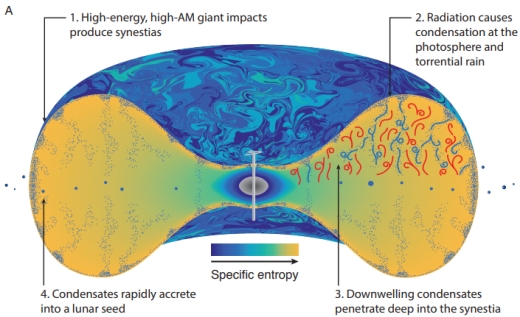
Image: Part of the paper’s Figure 18, illustrating Moon formation within a terrestrial synestia. Credit: Lock & Stewart.
The next image, likewise part of Figure 18 in the paper, shows the emergence of the Moon within the synestia as the latter contracts. Credit: Lock & Stewart.
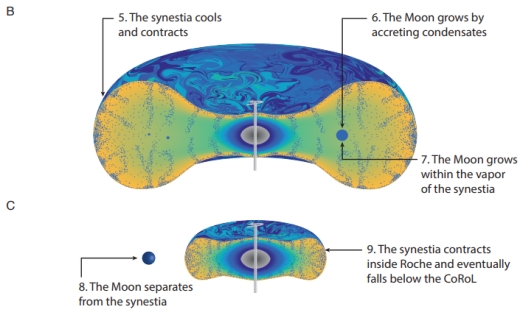
The impact scenario for lunar formation thus shifts to a study of the properties of the synestia that produced the Moon. The similarity in isotopes between the Earth and the Moon is an issue because simulations of giant impacts under the older model produce a lunar disk made primarily of material from the impacting body. But isotope ratios vary among the planets. We would expect differences within these ratios if the Moon formed largely from the impactor’s materials.
Under the synestia model, Earth and Moon emerge from the same cloud of vaporized rock, explaining the isotopic similarity. In this scenario, a planetary satellite forms inside the planet it will orbit. Lock and Stewart explain the Moon’s lack of volatile elements by the same formation story, with the forming Moon surrounded by high-temperature material from the synestia. The paper adds:
The MVEs [moderately volatile elements] that are not incorporated into the Moon remain in the synestia. As the synestia cools and contracts within the lunar orbit, the remaining MVEs are destined to be incorporated into the bulk silicate Earth.
This is a complicated model, but Stewart points out in this Harvard news release that it replicates features of the Moon’s composition that are otherwise hard to explain. Further exploration of synestias will be useful as we model what happens in early exoplanet systems, where collisions on a similar colossal scale should be a feature of planet formation.
The paper is Lock et al., “The Origin of the Moon within a Terrestrial Synestia,” Journal of Geographysical Research: Planets 28 February 2018 (abstract / preprint). The 2017 paper is Lock & Stewart, “The structure of terrestrial bodies: Impact heating, corotation limits, and synestias,” Journal of Geophysical Research: Planets 122 (2017). Abstract / preprint.

Probing a ‘Hot Saturn’
When researchers talk about ‘hot Saturns,’ it’s natural to imagine a ringed planet in a close orbit to its star, rings being Saturn’s most prominent feature. But WASP-39b hardly fits this picture. Some 700 light years from Earth in the constellation Virgo, this is a tidally locked world that is 20 times closer to its star than the Earth is to the Sun. WASP-39 itself is a G-class star of about 90 percent of the Sun’s mass. We have no evidence of planetary rings here, but we do see a planet whose temperature reaches 776 degrees Celsius, with a nightside not much cooler.
What keeps this world from being called a ‘hot Jupiter’ is its low density coupled with a large radius, some 1.27 times that of Jupiter (its density is about 0.28 times that of Jupiter). ‘Puffy’ planets like this show density levels far more like Saturn, and they orbit close to their stars, accounting for their extended atmospheres. WASP-39b’s atmosphere appears free of high-altitude clouds, allowing detailed study of its composition. Now we have word that the planet shows the signature of water vapor, three times as much as found on Saturn.
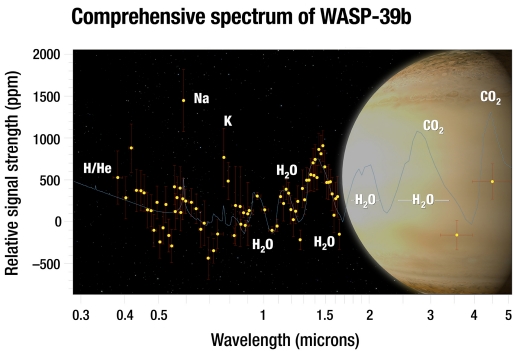
Image: Using Hubble and Spitzer, astronomers analyzed the atmosphere of the “hot Saturn” exoplanet WASP-39b, and they captured the most complete spectrum of an exoplanet’s atmosphere possible with present-day technology. By dissecting starlight filtering through the planet’s atmosphere into its component colors, the team found clear evidence for water vapor. Although the researchers predicted they would see water, they were surprised by how much water they found – three times as much water as Saturn has. Credit: NASA, ESA, G. Bacon and A. Feild (STScI), and H. Wakeford (STScI/Univ. of Exeter).
Transmission spectroscopy is the method here, analyzing light from the host star as it filters through the planet’s atmosphere during a transit. Hannah Wakeford (STscI and University of Exeter) is lead investigator on the WASP-39b work. Retrieved with the Hubble Space Telescope and the Spitzer instrument, her team’s data provide about as complete a spectrum of an exoplanetary atmosphere as current technology will allow. Says Wakeford: “This spectrum is thus far the most beautiful example we have of what a clear exoplanet atmosphere looks like.”
The formation history of worlds like these is suggested by the unexpectedly high values for water vapor. The implication is that the planet must have formed far from the star, beyond the snowline in a region where icy materials are abundant. That would mean a planetary migration into the inner system, perhaps creating havoc among smaller planets in inner orbits.
“WASP-39b shows exoplanets can have much different compositions than those of our solar system,” said co-author David Sing of the University of Exeter. “Hopefully, this diversity we see in exoplanets will give us clues in figuring out all the different ways a planet can form and evolve.”
The next move in the WASP-39b story will be to subject it to the James Webb Space Telescope, assuming a successful launch in 2019 (or perhaps later, given the recent report from the Government Accountability Office — see Marina Koren’s excellent analysis in The Atlantic for more on the problem). Once JWST is available, a more complete spectrum including atmospheric carbon will become possible, fleshing out our understanding of this unusual planet’s formation.

A Plausible Path for Life on Enceladus
Cassini has shown us that the plumes of Enceladus are laden not just with ammonia and carbon dioxide but also traces of methane. Scientists at the University of Vienna (Austria) are not claiming this finding as evidence for life, but they have produced laboratory work showing that at least one kind of microbe could survive in conditions like those within the moon. Couple this with the presence of molecular hydrogen (H2), also found within the plumes, and the existence of microorganisms deep within Enceladus appears at least plausible. Some of the methane found in the Enceladus plumes may turn out to be produced by methanogens.
The microorganism in question is Methanothermococcus okinawensis, which can be found around sea vents in the Okinawa Trough off Japan. In conditions like these, methanogenic archaea can sustain themselves by the chemical nutrients found around hydrothermal vents, a scenario that could likewise exist beneath the Enceladus ice.
Simon Rittmann, working with colleagues in Austria and Germany, put the microbe into Enceladus-like conditions in a series of laboratory tests, varying the amount of molecular hydrogen. Demonstrating the survival of the archaea involved introducing different values for pressure and pH, assuming abundant carbon dioxide and molecular hydrogen’s store of energy. M. okinawensis demonstrated that it could survive, producing methane as a by-product.
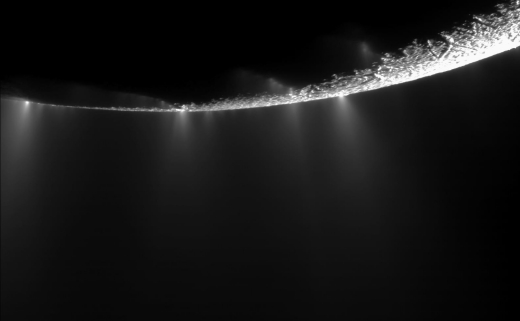
Image: Plumes erupting off the surface of Enceladus, an icy moon. Credit: NASA/JPL/SSI.
At the floor of the Enceladus ocean, temperatures above 0 degrees Celsius are likely to exist in a region abundant in rock and minerals. Enough molecular hydrogen could be produced by reactions involving the mineral olivine to sustain these lifeforms. The process is called serpentinization, involving interactions between seawater and rocks in the moon’s mantle that can also produce methane (CH4) and hydrogen sulfide (H2S). The experimental work shows that serpentinization reactions can support a rate of molecular hydrogen production high enough to sustain this kind of organism. As the paper notes:
When simultaneously applying putative gaseous (Table 4) and liquid inhibitors (Supplementary Table 3) under high-pressure conditions, we reproducibly demonstrated that M. okinawensis was able to perform H2 /CO2 conversion and CH4 production under Enceladus-like conditions.
Thus the microorganism survives under the conditions Rittmann and team introduced into the laboratory, producing methane as it grows, a possible source of the methane found in Cassini observations. At this point in the investigation, we can’t rule out abiotic methane either.
Temperature is an interesting variable, as the paper goes on to show:
The mean temperature in the subsurface ocean of Enceladus might be just above 0 °C except for the areas where hydrothermal activity is assumed to occur. In these hydrothermal settings temperatures higher than 90 °C are supposedly possible, and are therefore the most likely sites for higher biological activity on Enceladus. Although methanogens are found over a wide temperature range on Earth, including temperatures around 0 °C, growth of these organisms at low temperatures is observed to be slow.
With enough molecular hydrogen produced through serpentinization to support methane production, the case for searching for methanogenic biosignatures is clear, an investigation explored briefly in the paper. We may be able to detect lipids and hydrocarbons as well as carbon isotope ratios that flag the presence of living organisms. This laboratory work makes the case for the kind of mission that will be needed to study possible Enceladus-based life in situ to learn whether methanogenic organisms are more than an extrapolation.
The Washington Post quotes Rittmann’s caveat:
“We tried to be as broad as possible with our assumptions,” Rittmann said. There are no direct measurements for what exists beneath Enceladus’s ice crust. “No one will be able to tell if these conditions are really occurring on Enceladus,” he said. “However, we did our best to be as careful as possible.”
The paper is Taubner et al., “Biological methane production under putative Enceladus-like conditions,” Nature Communications Vol. 9, 748 (2018). Full text.


